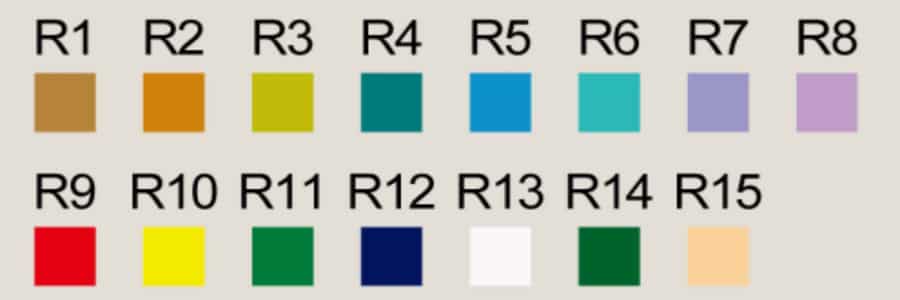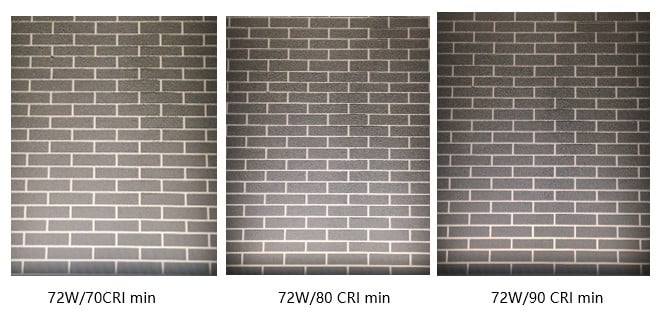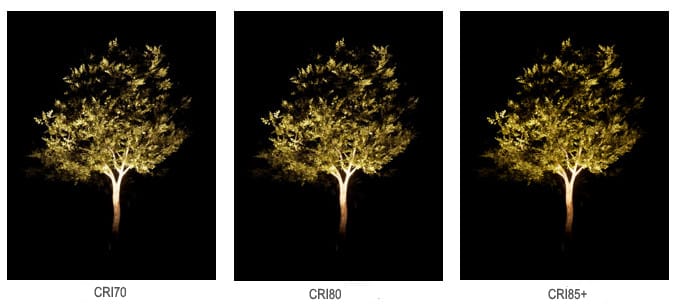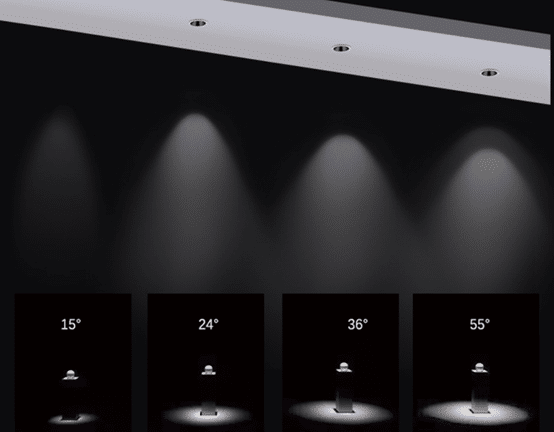What is the difference between CRI and Ra?
What is CRI?
Intuitive understanding: CRI (Color Render Index) is the abbreviation of color-rendering index. In layman’s terms, the color rendering index is a standard to measure the ability of a light source to reproduce colors. It can be understood as whether the color of the object will be distorted under the illumination of a certain light source, and the degree of distortion.
The below picture shows the color of the same potted flower under a light source with the same color temperature and different color rendering index.

It can be intuitively felt that the better the color rendering index (that is, the higher the color rendering index), the closer the color of the flower is to the true color.
Scientific definition: Color rendering is a qualitative evaluation that measures the degree to which the light source presents the color of an object, that is, the fidelity of the color. Light sources with high color rendering have better color reproduction, and the colors we see are closer to the natural primary colors (colors under the sun); light sources with low color rendering have poor color reproduction, what we see the color deviation is also large.
The Color Render Index (CRI) is currently a common method for defining the color rendering of a light source. It is used to quantitatively evaluate the color rendering of the light source. It is the comparison between the color of the object under the measured light source and the color of the object under the reference light source. Compliance degree.
The International Commission on Illumination (CIE) set the color rendering index of sunlight as 100. The color rendering index of incandescent lamps is very close to daylight, so it is regarded as an ideal reference light source.
CIE stipulates 15 test colors/standard color samples, and number these 15 total colors from 1-15
- numbers 1-8 are 8 natural colors, selected from Munsell color scale, including various representative colors, they have medium chroma and lightness;
- numbers 9-15 are 7 test colors, including red, yellow, green, blue with higher chroma, skin color of young European and American women, skin color of young Chinese women, leaf green.
Use R1-R15 to represent the color rendering index of the light source for these 15 colors. The 15 test colors are shown in the figure below:

What is Ra ?
Ra is the symbol of “general color rendering index”, which is the average value of the first eight common color blocks, (that is, R1+R2….+R8)/8, and its value represents the color rendering of the light source, with a maximum of 100. Ra, also known as color rendition, is one of the reference factors for measuring color rendition. The larger the value, the better the color rendition. From the perspective of protecting eyesight, the color rendering index of the lamps used must be greater than 80. Does that mean the bigger the Ra is, the color rendition is better? The answer is no, there is also a concept of R9. R9, also known as the comfort color rendering index, is the ability to display red in the color index. The higher the R9, the more it will show the true colors of things. R9 is an important factor to measure color reproduction, and only when Ra and R9 have high values at the same time,the high color rendering of LED can be guaranteed.
The Light Fixture CRI of different light source
| Light Source | Incandescent/halogen lamp | Xenon lights | Fluorescent lamp | LED Lights | Metal halide lamp | High-pressure mercury lamp | HPS Lamp |
|---|---|---|---|---|---|---|---|
| CRI | 95-100 | 95-98 | 51-90 | 70-95 | 60-95 | 22-50 | 20-30 |
Light, it also has quality, and there are high-quality and low-quality options. We can understand various types of light through the spectrum

The spectrum of sun light is very continuous and gentle. At the same time, its light-emitting surface is large, and the light distribution is very uniform. Other light sources have different shapes, ups and downs, and great fluctuations. This is only the difference in the spectrum of different light sources, and this difference make the inferior light cause external and intuitive problems such as low illumination, high color temperature, glare, severe stroboscopic, blue light hazards, and serious light decay , which in turn cause harm to our human body and psychology.
Remark:
- The theoretical color rendering index of incandescent lamps is 100, but there are many kinds of incandescent lamps in real life and their applications are different, so their Ra values are not completely the same, it can only be said to be close to 100, which is the lamp with the best color rendering. However, due to low light efficiency and insufficient energy saving and environmental protection, it has gradually withdrawn from the stage of history.
- Although the color rendering of LED lamps is not as good as that of incandescent lamps, they are currently a popular light source because they are energy-saving and environmentally friendly.
How to choose the color rendering index when purchasing LED lights?
Two principles can usually be followed when choosing color rendering of led lights, namely the principle of faithful color rendering and the principle of effect color rendering.
The principle of faithful color rendering
The principle of faithful color rendering refers to the need to use a light source with a high color rendering index in order to correctly express the original color of the object. In this case, you can choose according to Ra rating. The higher the Ra, the higher the faithfulness to the natural color of the object.
According to the different applicable venues, the International Commission on Illumination (CIE) divides the color rendering index into five categories:
| CRI category | Ra | Effects | Application places |
| 1A | 90-100 | excellent | Art galleries, museums |
| 1B | 80-89 | Good | Printing, painting, fiber and precision work factories; residential houses, hotels, restaurants |
| 2 | 60-79 | ordinary | Factory for general operations such as electromechanical assembly, surface treatment, control room, etc.; office and study are also allowed |
| 3 | 40-59 | Not good | Heavy industry factories such as machining, heat treatment, casting, etc., outdoor streets |
| 4 | 20-39 | bad | Warehouse lighting, build a metal warehouse, outdoor street lighting |
Principle of effect color rendering
The principle of effect color rendering refers to the selection of a specific color rendering index in order to clearly emphasize specific colors in special scenes such as meat product windows. In this case, usually under the premise of ensuring that Ra meets the requirements, it is necessary to select a color that improves the corresponding special color rendering index.
Example 1: For the lighting source of meat products in supermarkets and shops, the R9 color rendering index is particularly important, because the meat is usually reddish, and a high R9 can make the meat look fresher and more delicious.
Example 2: For studios, studios and other occasions where the skin color needs to be truly reproduced, the R15 index of the lighting source must not be low.
What should be paid attention to in terms of CRI for indoor and outdoor led lights?
In indoor lighting (such as downlight, panel lights) projects, due to the changeable objects (such as people, prints, fabrics, etc.), rich colors, short viewing distance, and high accuracy requirements for color reproduction, designers usually choose high CRI products, which require CRI >90;
Then how about the led lighting? Is the CRI of the Led lamp the higher the better? In fact, this is not necessarily correct. Because under the premise of the same wattage and color temperature, the higher the CRI of the light source, the lower the luminous flux, that is, the higher the CRI, the lower the brightness. The following is a comparison experiment of the effect of the same wattage and different CRI lamps in outdoor scenes.
CRI for outdoor wall lighting

Lighting for trees

It can be seen from the experiment that when the same wattage lamps illuminate the same object, the brightness of low CRI lamps is slightly higher, while the color of high CRI lights is slightly better.
There is a visual difference, but not much. At the same time, in outdoor landscape and architectural lighting, because the illuminated objects are relatively fixed (such as a building, a green brick road, trees, etc.), there are few color changes, and the scene is open, the viewing distance is far, and the environment is complex. Generally, the requirements for light efficiency are higher.
Therefore, when the scene accuracy requirements are not high and the investment budget is limited: from a more economical point of view (generally High CRI LED lights is much higher in cost than ordinary CRI Lights), Generally, CRI>70 can be used for lamps and lanterns for landscape lighting.

Hello, customers
My name is Ricky Wang, I’m the business manager of GRNLED. I have been in LED lights industry for more than 10 year. Feel free to contact us. I’m happy to provide you the best service and products.
Email: info@grnled.com | WeChat: ledfixture






